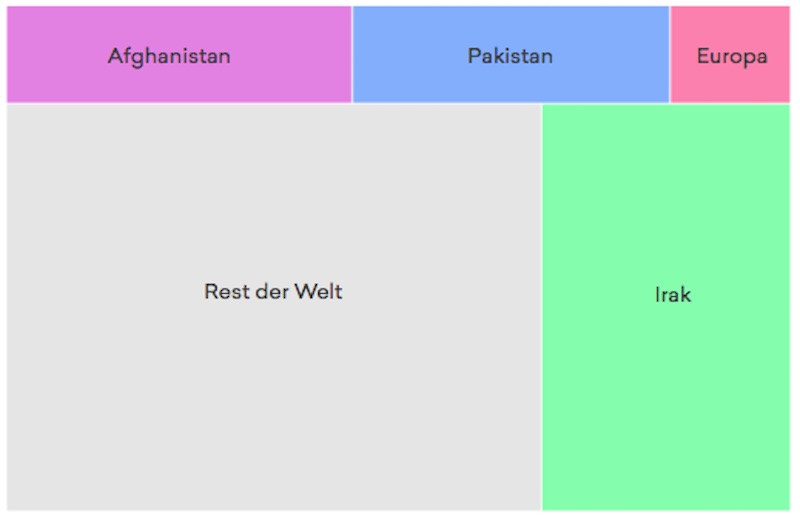Get the weekly SPARTANAT newsletter.
Your bonus: the free E-Book from SPARTANAT.

Terrorism (2): The history of terror in Europe, visualized
Analysis of terrorist attacks in Europe from 1970 to 2016 reveals a total of 4,280 attacks, resulting in 5,700 deaths and 16,400 injuries. Trends show 92% of ethno-nationalist terror victims were before 2000, with bombings causing the most casualties.
Paris, London, Berlin: In recent years, hundreds of people have fallen victim to Islamist terrorism in Europe. But was everything really better before? An analysis of the largest terrorism database in the world from a European perspective.
By bus into the crowd. With a suicide vest in the subway station. With a knife in the city center against a police officer: Terrorism has taken on various forms in recent years. However, it is not a new phenomenon. From 1970 to 2016, about 4,280 attacks have occurred in Europe. About 5,700 people have been killed and about 16,400 people have been injured. This is shown in a data analysis of the Global Terrorism Database, which is compiled annually by researchers at the University of Maryland (USA).
Over the past 46 years, there have been periods when the European population has been plagued by waves of terrorism. Geographically, attacks are concentrated in three countries: 61 percent of all killed and injured people are in the United Kingdom (20%), Spain (27%), and France (14%). Terrorist incidents are particularly frequent in Northern Ireland, northeastern Spain, as well as in London, Madrid, and Paris. The motives and ideologies of the attackers vary from region to region.
In Northern Ireland and northeastern Spain, attacks by the Irish Republican Army and "Euskadi Ta Askatasuna" dominate—both better known by their acronyms IRA and ETA. They sought to push for independence of their regions through terrorist means.
This form of terrorism has become rare. 92 percent of the total number of victims of ethno-nationalist terror are attributable to the time before 2000. In the thirty years prior to the turn of the millennium, it was responsible for about 9,200 out of about 16,000 terrorism victims (58%) across Europe.
Also, around 2,500 of the 4,300 attacks before the year 2000 are attributable to ethno-nationalist terror. After that, the number of terrorist attacks in Europe in general has remained at a lower level compared to the 1970s, 80s, and 90s. Nine percent of all terrorist incidents since 1970 have occurred since the turn of the millennium.
However, 27 percent of all victims are in the more recent period. A conclusion from this is that although attacks are less frequent, they result in more deaths and injuries. In Europe, bombings are responsible for the most deaths and injuries. Two-thirds of all victims in the past 46 years can be attributed to this form of attack. Attacks with firearms, such as those in Paris, are the third most common type of attack after targeted killings or attempted killings.
This pattern is not only evident in Europe but also in the analysis of terrorism figures on a global level since 1970. It also reveals that 42 percent of the around 690,000 global victims of terrorism are in three countries: Afghanistan, Pakistan, and Iraq.
 The share of Europe: 3 percent.
The share of Europe: 3 percent.
Regarding the Categorization of Ideologies
Addendum has researched and categorized the ideological backgrounds of all terrorist groups that have injured and/or killed people in Europe. The categories correspond to those of Rothenberger & Müller (2015), but have been expanded to include right-wing terrorism.
- Religious: includes all terrorist groups with religious fundamentalist motivations. This form of terrorism can be found in the history of all world religions, with the currently most violent form being Islamist terrorism.
- Ethno-nationalist: encompasses terrorist groups that represent a minority or oppressed group of the population and whose main goal is their own state or another form of political autonomy. Since these groups often emphasize the importance of their own culture, which they see threatened by modernization, migration, or the growing central state, a clear distinction from right-wing terrorism is sometimes difficult to implement.
- Left: includes all terrorist groups that explicitly or implicitly base themselves on Karl Marx and historically subsequent ideologies. These groups seek a radical reform of political and social structures through armed resistance against capitalism, imperialism, and global inequality.
- Right: includes all groups that see their origin and culture threatened by other population groups and/or want to enforce a fascist societal model through violence. Additionally, this category includes all incidents where the groups of perpetrators are unknown, but target clear objectives such as asylum seeker homes.
It is difficult to classify some terrorist groups into just one of these categories. Some have more than one motivation. For example, the "Islamic State" is primarily motivated by religion. However, it also aims for its own state, and could therefore be described as ethno-nationalist.
The Image Concept:
For the visual representation of our project, we captured a MAN TGL 8.18 12t truck with a box body at prominent places in Austria, as similar types of vehicles have recently been used as weapons in various terrorist attacks in Europe. The question we ask ourselves is: Do we have to learn to live with terrorism? Including in Austria.
ADDENDUM Article series on Terrorism on SPARTANAT:
Part 1: Criminals, Heroes, Freedom Fighters
Part 2: The History of Terrorism in Europe, Visualized
More to come ...
This article was first published on ADDENDUM. Copyright Text: ADDENDUM. Images: ADDENDUM. Video contributions, graphics, and audio contributions: ADDENDUM.
ADDENDUM on the Internet: www.addendum.org
SPARTANAT is the online magazine for Military News, Tactical Life, Gear & Reviews.
Send us your news: [email protected]
Ad
similar
Get the weekly SPARTANAT newsletter.
Your bonus: the free E-Book from SPARTANAT.


